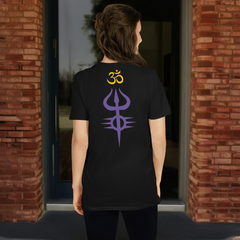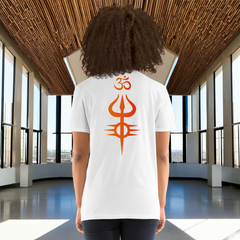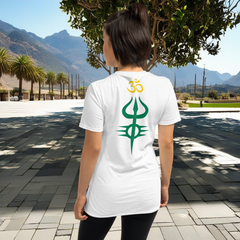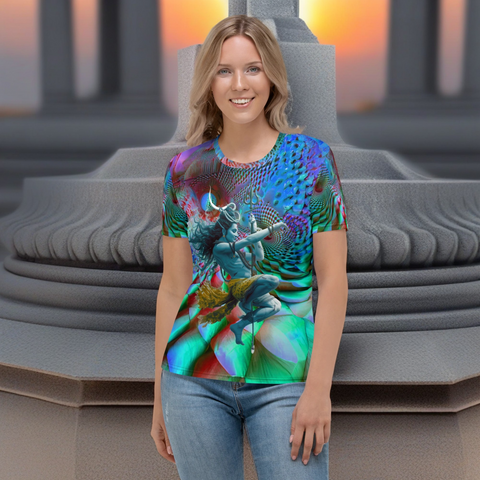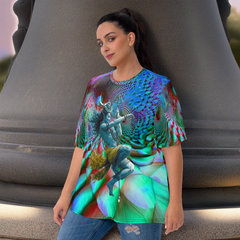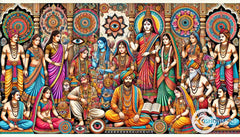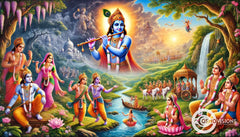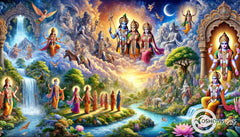Story of Shiva and Parvati: A Symbol of Love and Faithfulness
Posted by Massimiliano Geraci
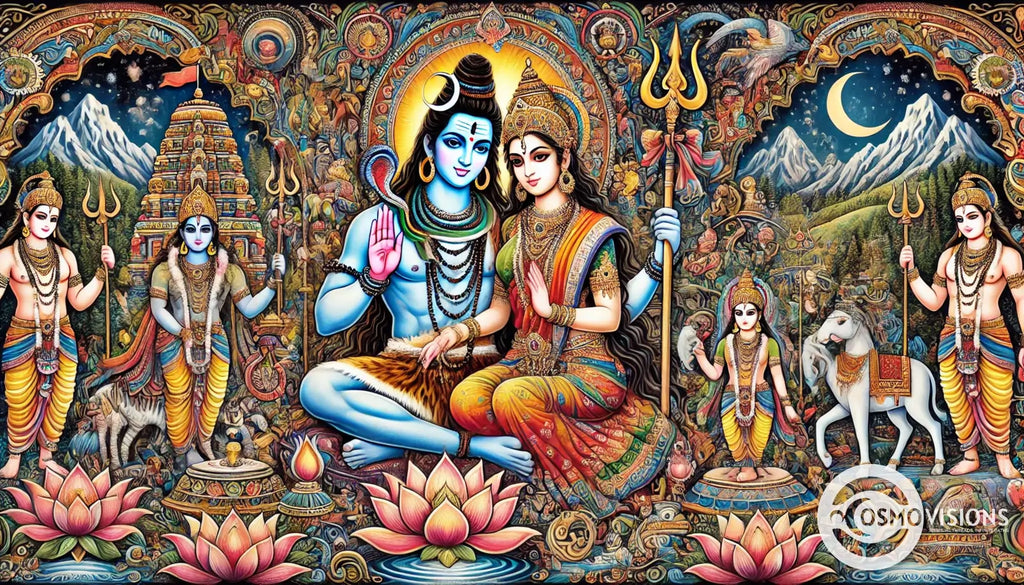
Many people find themselves drawn to tales of love that transcend the ordinary, seeking stories that resonate with themes of commitment and eternal devotion. The story of Shiva and Parvati, Shiva's wife, is one such narrative, deeply rooted in Hindu mythology. Parvati, an embodiment of divine knowledge and the mother of the world, offers lessons in love unlike any other.
This divine couple exemplifies unwavering faithfulness amidst the trials they endure, showcasing a bond that is both inspirational and aspirational.
A fascinating aspect of their tale is how it symbolizes the union of masculine and feminine energies within the universe. Through their story, we learn about the power of perseverance in love and the spiritual significance behind their marriage.
Our article aims to explore these themes deeply, providing insights into why Shiva and Parvati’s relationship remains a revered symbol of love and faithfulness across cultures. Discover what makes their bond so unique.
Who are Shiva and Parvati in Hindu Mythology?
Shiva and Parvati hold a paramount place in Hindu mythology, symbolizing the union of masculine and feminine energies which is essential for creation and destruction. Shiva, known as the destroyer within the Trimurti, embodies asceticism and the power of transformation.
His consort, Parvati, represents love, fertility, devotion, and strength. She is considered as the mother of goddesses in Hinduism and encompasses all aspects of divine femininity. Her reincarnation from Sati to Parvati showcases her perseverance in love for Shiva.
Their marriage marks their indissoluble love and signifies a balance that sustains the universe’s harmony. Together, they parent Ganesha and Kartikeya—deities who themselves are respected figures within Hindu lore.
As Ardhanarishvara—the composite form blending both deities—Shiva and Parvati epitomize how opposites can coexist in profound harmony. In unity there is strength; Shiva without Parvati or vice versa would cease to be powerful.
The Thiruvathira festival, celebrated in Tamil Nadu, honors the meeting of Shiva and Parvati, with women performing Thiruvathirakali and singing Thiruvathira paattu.
Understanding the Divine Energy of Shiva
The divine energy of Shiva, recognized as one of the principal deities in Hinduism, embodies the complex concepts of destruction and regeneration. His energy is not just about ruin but is vital for change, making room for new creations by dissolving outdated forms and illusions.
This transformative power mirrors nature’s cyclical processes—death leading to rebirth—which sustains the universe's continual flux. Shiva's dance, Tandava, symbolizes this cosmic cycle, showcasing his role as both destroyer and creator within Hindu cosmology.
Examining Shiva's energies reveals a profound spiritual depth encompassing more than destruction—his presence nurtures growth by allowing for transformation. As Lord of Shaivism, he draws devotees closer to understanding the impermanence of physical existence and the eternal soul's journey toward liberation (moksha).
Through tales recounted in texts like Shiv Purana and Mahabharata, followers learn about his grace that extends beyond mere wrath; it fosters enlightenment by removing ignorance’s veil.
This duality makes him a deity associated with powerful forces and a guardian guiding humanity towards spiritual awakening amidst life’s trials.
The Grace of Goddess Parvati: Goddess of Love and Devotion
Goddess Parvati, revered as the mother of love and devotion in Hindu mythology, embodies the nurturing aspect of divinity. Her tales in texts such as the Devi Bhagavata Purana and Devi Mahatmya illustrate a profound commitment to the god Shiva, making her an epitome of bhakti (devotion) and shakti (power).
Displaying unparalleled beauty and wisdom, she ascends from her birthplace in the Himalayas, daughter to Himavan and Mena, marrying lord Shiva through a deep display of penance and perseverance.
This act not just highlights her unwavering love but also marks a symbolic union between divine feminine and masculine energies.
Her stories with Lord Shiva offer insights into a relationship based on mutual respect, power of love, and sacrifice against odds—principles greatly valued within Hinduism's rich narrative framework.
Parvati's journey from meditative solitude back to marital bliss with Shiva showcases how devotion can transcend celestial boundaries. This goddess’s grace transcends beyond being merely wife of Lord Shiva; it encapsulates the entirety of unconditional love’s spectrum—making her worship paramount among devotees seeking guidance for their spiritual paths toward ultimate unity with the divine.

The Symbolic Union of Shiva and Parvati: Masculine and Feminine Energies
The union of Shiva and Parvati symbolizes the perfect balance between masculine and feminine energies, an essential concept in Hindu traditions. This cosmic couple's marriage brings together Shiva's destructive power with Parvati's nurturing love, illustrating how opposing forces can create harmony.
Their sacred union is celebrated in various rituals and mythologies, reflecting the deep spiritual significance of their relationship.
Through stories passed down in texts like the Puranas and depicted in art across India, this divine pairing teaches us about the power of love and devotion. It shows that qualities such as strength and compassion are not exclusive to one gender but are complementary aspects of a whole.
The marriage of Shiva to Parvati marks not just a celestial event but acts as a guiding principle for balanced relationships where respect and understanding prevail. By embodying both toughness like the mountain Himavat (Parvati’s father) and tenderness akin to nourishment, their story continues to inspire millions on their own spiritual journeys to unity within diversity.
What is the Love Story of Shiva and Parvati?
Shiva and Parvati's love story begins with the reincarnation of Sati, Shiva's first wife, into Parvati, the daughter of the king of the mountains. Determined to win Shiva's heart once again, Parvati undertook severe penance to draw him out of his deep meditation.
Despite being born a princess, she chose a life of austerity to prove her unwavering love and devotion. Her perseverance paid off when Shiva, adorned with the crescent moon and wielding his trident, finally noticed her sincere efforts and recognized her as the rebirth of Sati.
Their marriage marked a celestial celebration that brought harmony between gods (devas) and goddesses, symbolizing the union of masculine and feminine energies. This divine couple embodies profound spiritual teachings through their relationship, highlighting themes like devotion leading to ultimate enlightenment (moksha).
Shiva opened his third eye in acceptance of Parvati’s unparalleled dedication, making their bond an exemplar for followers seeking eternal love. Guided by sage Narada, who alleviated Parvati’s fear and doubts, they united as half Shiva (Ardhanarishvara), embodying the perfect balance of energies.
Through tales woven around them—such as Lord Ganesha's birth or Kartikeya taking on challenges under their guidance—they inspire values like faithfulness and perseverance across generations in Hindu mythology. The image of Shiva dancing with Parvati by his side, encapsulates their dynamic and eternal love story.

The Birth and Reincarnation of Goddess Parvati
Goddess Parvati, revered as the mother of Tantra and a core deity in Shaktism, signifies the reincarnation of Sati, the first wife of Lord Shiva. After Sati's self-immolation at Daksha's yagna, aggrieved Shiva retreated into deep meditation.
The rebirth of Parvati was prophesied to bring him back from his sorrow. She emerged reborn as the daughter of Himavat, the god of mountains, embodying grace and divine strength. This pivotal event marked not just the return of Devi to her consort but also reinstated balance and fertility to the cosmos.
Her pursuit to marry Shiva entailed rigorous penance and devotion, underscoring her unwavering love for him. Despite being born into royalty, Parvati chose asceticism over comfort to prove her dedication and ultimately married Shiva.
This act underscores themes central to Hindu mythology such as rebirth for fulfilling uncompleted love and duty. Through her journey from birth to becoming Shiva’s wife again in this new form, Parvati exemplifies resilience and determination in face of hardships—a beacon for devotees seeking spiritual growth through persistence and faithfulness.
Penance and Perseverance: How Parvati Won Shiva's Love
Parvati showed unmatched dedication to win the heart of Shiva, engaging in rigorous penance and perseverance. Unlike anyone before, Parvati devoted herself to meditation and ascetic practices in the harsh Himalayas, demonstrating her unwavering love and commitment.
She focused on a deep spiritual journey to attract Shiva's attention, proving her worthiness as his consort. This act of devotion was not just a testament to her love but also a symbol of her strength and determination.
Shiva, initially unresponsive due to his grief over Sati's death, could no longer ignore Parvati’s profound dedication. Her persistent devotion melted his heart, leading him to accept her love finally.
The story is a powerful illustration of how true devotion can overcome even the greatest obstacles. It teaches that patience and steadfastness are virtues capable of bringing divine blessings.
Following this tale of divine romance, the sacred marriage between Shiva and Parvati becomes a celestial celebration worthy of all the gods among themselves.
Through penance and perseverance, Parvati embodies the essence of true love.
The Marriage of Shiva and Parvati: A Celestial Celebration
The marriage of Shiva and Parvati stands as a monumental event in Hindu mythology, symbolizing the union of powerful deities with profound implications for cosmic balance. Celestial beings, gods, and sages gathered to witness this divine matrimony, orchestrated by Lord Vishnu himself.
This sacred alliance was not merely an expression of love but a restoration of equilibrium to the universe. Through their union, Parvati brought Shiva back from his ascetic withdrawal following the death of Sati, thereby enabling him to re-engage in worldly affairs.
The celebration marked by joyous festivities became a cornerstone story in Shaivism tradition.
Shiva's acceptance to marry Parvati came after her intense penance and devotion, demonstrating the power of unwavering faith and perseverance. Their wedding is celebrated annually as Maha Shivaratri by millions who honor the wedding of their god of destruction turned god of love through fasting, chanting mantras related to Shiva, and reflecting on virtues such as honesty, forgiveness, and self-discipline.
This celestial celebration transcends mere mythological narratives; it embeds deep spiritual lessons into the cultural fabric across South India where temples dedicated to them abound with sculptures narrating this timeless love story.
What Makes Shiva and Parvati a Symbol of Love?
Shiva and Parvati's union epitomizes the quintessential power of love and devotion, transcending mere tales to embody spiritual allegories. Parvati’s unwavering love for Shiva, demonstrated through her intense penance, speaks volumes about faithfulness.
Her determination to win over Shiva after his deep mourning for his beloved Sati, showcases the profound strength of true love’s perseverance. This act of pure devotion led Shiva to open his eyes to a life of companionship with Parvati and shiva together, symbolizing that genuine affection can soften even the hardest hearts and bring about transformation.
Their marriage is celebrated as a celestial event across Hindu mythology, signifying not just their union but also the merging of masculine and feminine energies creating harmony in the universe.
Couples idolize them for their commitment to each other despite numerous challenges. As parents to Kartikeya and Ganesha, they present ideals in family unity and parental roles within Hinduism.
Their stories serve as pivotal lessons on how balance can be achieved between power and gentleness, destruction and creation, thus making Shiva-Parvati an eternal symbol of conjugal love fused with divine grace.
The Power of Love and Devotion in Their Relationship
The tale of Shiva and Parvati epitomizes the transformative power of love and unwavering devotion. Parvati's deep affection for Shiva, her perseverance through penance to win his heart, and their subsequent marriage mark a celestial celebration of commitment.
This saga reinforces the sacred bond shared by them and symbolizes the union of divine energies which is celebrated in Hinduism. Through their story, followers find inspiration in Parvathi's undying determination to have Shiva as her husband and in how she embodies love and devotion.
Their relationship serves as a cornerstone for lessons on faithfulness and spiritual enlightenment within the context of Hindu marital traditions. By marrying Parvati, Shiva found balance again after he lost Sati, showing that true love transcends life's adversities.
The birth of their sons Ganesha and Kartikeya further cements this bond, portraying a harmonious blend of strength, wisdom, and familial unity. Such narratives deeply resonate with anthropology enthusiasts, spirituality seekers, and lovers of Indic art who admire the enduring legacy conveyed through timeless stories like that of Shiva returning to love with Parvati at his side.
Love in its purest form brings about cosmic harmony.
Lessons in Faithfulness from Shiva and Parvati
Shiva and Parvati's saga teaches profound lessons in faithfulness, showcasing the depth of love and devotion that binds divine entities. Parvati’s unwavering love for Shiva, demonstrated through her rigorous penance to win his affection after he lost Sati, exemplifies unparalleled commitment.
Her actions reveal that true love transcends physical boundaries, resting on the pillars of faithfulness and spiritual connection. Shiva reciprocated this fidelity by accepting Parvati as his wife, illustrating the mutual respect and loyalty foundational to their union.
Their story further illuminates how challenges within relationships can fortify bonds when approached with sincerity and devotion. Through their marriage, celebrated across heavens and earth as a symbol of celestial unity, they taught the world and humanity about the power of steadfastness in face of adversities.
Love flourished between them not because it was predestined but because they nurtured it with patience, understanding each other’s strengths and vulnerabilities. This narrative leads us into exploring "The Spiritual Significance of Their Union," where we examine deeper into how Shiva and Parviti's relationship transcends personal attachment to embody universal principles.
The Spiritual Significance of Their Union
Transitioning from the lessons in faithfulness between Shiva and Parvati, their union unfolds a deeper spiritual significance that resonates well beyond mere tales of devotion. The marriage between Shiva and Parvati is not just an event; it symbolizes the harmonious balance of masculine and feminine energies within the universe.
This divine couple exemplifies how contrasting forces can come together to create a state of equilibrium, guiding humanity's spiritual journey towards enlightenment.
Their sacred union goes further, embodying essential principles found in ancient texts like the Vedas and Upanishads. Through their relationship, devotees learn about love's power to transcend superficial bonds, reaching into soulful depths where true connectivity resides.
The stories surrounding their marriage, celebrated with rituals such as vivaha, reflect significant cultural practices that continue to influence Hindu weddings today. By embracing qualities such as perseverance shown by Parvati’s unwavering love and Shiva’s eventual acceptance, they teach valuable life lessons on patience and fidelity—core tenets for spiritual growth among followers across generations.
What are the Major Stories Related to Shiva and Parvati?
The tale of Sati and her rebirth as Parvati marks a poignant beginning in the lore of Shiva and Parvati. Devi Sati, unable to bear her father's disrespect towards Shiva, immolates herself.
This act leaves Shiva engulfed in sorrow, performing the destructive Tandava dance. Sati is reborn as Parvato bolster Hindu deities' collective strength against demons, ultimately seeking to win back lord Shiva's love through rigorous penance.
The birth of their son Ganesha follows an interesting narrative; worried for her safety while bathing, Parvati creates Ganesha from turmeric paste off her body and gives him life, assigning him to guard the entrance. When Shiva returns and finds his way barred by this unknown child, a conflict ensues leading to Ganesha’s beheading. Realizing his grave mistake after learning Ganesha’s identity from a distraught Parvati, Shiva replaces Ganesha's head with that of an elephant thus granting him life once again.
The Tale of Sati and How Parvati Came into the Picture
Sati, the first consort of Shiva, embodies devotion and fidelity. Her tale unfolds with profound love for Shiva, leading to her self-immolation at Daksha's yagna due to disrespect towards her husband.
This act of ultimate sacrifice signified unwavering loyalty but left Shiva plunged into grief, isolating himself in meditation. Sati’s reincarnation as Parvati marks a pivotal moment in Hindu mythology, symbolizing resilience and undying love.
Parvati's journey began as Sati's rebirth with an unyielding resolve to win back Shiva’s affection. Undertaking severe penance amidst the harsh conditions of the Himalayas showcases her extraordinary determination.
Parvati’s relentless devotion eventually softens Shiva’s heart; his acceptance to marry her again reiterates themes of regeneration and eternal love within Hindu cosmology. Their union celebrates the revival of love and reinstates harmony in the cosmos, illustrating how true dedication transcends boundaries and prevails over despair.
The Birth of Ganesha and the Role of Shiva and Parvati
Goddess Parvati, desiring the joy of motherhood and a companion in her loneliness when her husband Lord Shiva was immersed in deep meditation, created Ganesha from ash. She gave life to this form with her divine powers, envisaging a child who embodied love and affection.
Parvati's act of creation underscores her aspects as Tripura Sundari and Mahadevi, blending the tender care of a mother with the profound energies of goddesshood. This narrative enriches Hindu mythology and celebrates the maternal instinct intertwined with divine creation.
The arrival of Ganesha brought unforeseen challenges that tested Shiva and Parvati's unity and wisdom. Unaware of Ganesha's origin, Shiva encountered him guarding Parvati’s chamber and, in a sequence of cosmic events sparked by confusion and protectiveness over his domain, beheaded him.
The anguish that followed saw interventions from Brahma and other deities, urging Shiva to restore their son’s life. Incorporating an elephant's head onto Ganesha’s body symbolizes the amalgamation of human intellectual capabilities with immense strength, marking the birth of one revered as Vighnaharta - the remover of obstacles.
This tale encapsulates themes like devotion within marital bonds exemplified by Parvathi’s love for Shiva during moments that called for both reconciliation and celebration within celestial narratives.

Stories of Kartikeya and His Parents, Shiva, and Parvati
Kartikeya, the son of Lord Shiva and Parvati, holds an esteemed place in Hindu mythology. Born to slay the demon Tarakasura, his birth story intertwines divine power with deep devotion.
Shiva granted this boon only after being convinced by the other king in love of Parvati, showcasing an unparalleled union of strength and affection. Kartikeya's tales are marked by his swift actions as he leads divine armies into battle, riding his peacock and wielding a spear given by his mother.
These stories highlight the martial prowess and strategic mind of Kartikeya and reflect on Shiva and Parvati's roles as doting parents who equipped their son with wisdom. Their guidance helped Kartikeya face challenges with courage and integrity.
Through these narratives, one observes how familial bonds within celestial spheres mirror human emotions, teaching lessons on valor, love, and duty.
How is Parvati's Love for Shiva Exemplified in Mantras?
Parvati's love for Shiva resonates deeply through the vibrations of sacred mantras, where her unwavering devotion and determination to marry Shiva unfold. These mantras embody Parvati’s journey from intense penance to the blissful union with Shiva, signifying how love transcends mere emotions and manifests into divine energy.
Reciting these mantras allows devotees to tap into the powerful bond shared by Parvati and Shiva, channeling their cosmic energies of creation, preservation, and destruction. The Lingam and Yoni symbols further encapsulate their eternal love, representing masculine and feminine forces in a harmonious existence.
The significance of Kamadeva's arrow in their story highlights the transformative power of love; it was his own power as an instrument that momentarily infuriated Shiva but their love making ultimately led him back to Parvati’s arms.
In rituals involving these deities, invoking Kamadeva alongside chanting specific mantras dedicated to Parvatri ensures spiritual lovers seek physical and eternal companionship with each other under their auspices.
Through such practices rooted in deep spirituality and reverence for divine union as illustrated between Shiva returned upon realizing his undying affection for Parvati-shakti is perpetuated among followers seeking a similar path towards enlightenment.
Next discussed is the pivotal role both deities play within Hinduism itself.
Understanding Shiva and Parvati Mantras
Shiva and Parvati mantras offer a gateway to accessing divine energies, embodying the spiritual essence of both deities. Each mantra serves as a powerful tool for devotion, aiding worshippers in their pursuit of spiritual growth and enlightenment.
Reciting these mantras allows devotees to connect with the profound love and strength that Shiva and Parvati's union represents. As symbols of destruction and regeneration (Shiva) alongside love and devotion (Parvati), these mantras encapsulate the dynamic balance of masculine and feminine forces within the universe.
Devotees often turn to specific verses like those found in sacred texts such as the Kena Upanishad or Mahabhagavata Purana for guidance on how to honor these deities properly. Chanting names from Shailaputri, an aspect of Parvati, or invoking Shiva through "Om Namah Shivaya" transcends mere verbal expression; it becomes a meditative practice infusing one's life with vibrational energy akin to divine attributes—resilience from Shiva paired with nurturing wisdom from Parvati.
This spiritual practice deepens one’s connection with the deities and their own inner divinity, reflecting core principles integral to Hinduism woven into daily rituals at temples across landscapes rich in tradition like India.
The Energy and Power of Reciting Mantras
Reciting mantras, sacred phrases deeply rooted in Hindu traditions, serves as a potent conduit to divine energies. These utterances connect individuals with the profound spiritual essence of deities like Shiva and Parvati, whose stories are emblematic of love, power, and devotion within texts such as the Ramayana.
Engaging with these mantras allows devotees to channel the divine energy that pervades the universe, fostering an intimate bond between the human and the ethereal realms.
Practitioners believe that through consistent recitation, these mantras transcend mere vocal expressions to become manifestations of cosmic energy themselves. Each chant embodies specific vibrations that align one's own energy with universal forces.
This alignment not only enhances personal spirituality but also contributes to a broader understanding and appreciation of Hinduism's rich narrative landscape — from tales of Parvati’s unwavering love for Shiva to their illustrious marriage that symbolizes union beyond mere mortal comprehension.
Through this practice of meditation, followers start a transformative journey toward inner peace and enlightenment.
What is the Role of Shiva and Parvati in Hinduism?
Shiva and Parvati hold an eminent position in Hinduism, embodying the quintessential union of divine masculine and feminine energies. Their narratives influence cultural practices, devotional rituals, and artistic expressions across generations.
As central figures in Shaivism, one of the major traditions within Hinduism, their stories are engraved in the sacred texts and myths that shape spiritual beliefs. The deity status of Shiva as part of the Tridevi - alongside Lakshmi (Goddess of Wealth) and Saraswati (Goddess of Knowledge), with Parvati symbolizing power (Shakti), love, fertility, and devotion - integrates deeply into daily religious activities.
Their legends serve as archetypal lessons on balance between destruction and regeneration (Shiva's role) and nurturing tenderness coupled with fierce strength (Parvati’s essence).
This duality illustrates the dynamic interplay necessary for maintaining cosmic harmony. Devotees engage with them through various practices such as chanting mantras dedicated to Shiva for liberation or seeking blessings from Parvati in aspects related to familial happiness or spiritual growth.
Festivals celebrating their marriage reaffirm communal bonds while acknowledging their importance within Hindu temple iconography where they are often depicted together symbolizing marital fidelity and mutual respect among couples aspiring to mirror this divine relationship.
The Cultural Impact of Lord Shiva and Goddess Parvati in Hindu Traditions
The cultural impact of Lord Shiva and Goddess Parvati resonates deeply within the world of Hindu traditions, shaping rituals, art, and literature. Their divine tales inspire numerous festivals across India and world, notably the sacred marriage ceremony celebrated in the month of Phalguna, which attracts millions of devotees yearly.
Art forms such as classical dance and temple architecture often depict scenes from their life stories, embodying the spiritual essence of their union. Characters like Kalidasa in Sanskrit literature have immortalized their love and power through epic poems that continue to influence Indian culture.
Devotees express reverence for Shiva and Parvati through various mantras and prayers that highlight different aspects of Parvati’s devotion and Shiva's might. The recitation of these mantras during religious ceremonies serves as a spiritual practice and strengthens family bonds by honoring their embodiment of a harmonious marital relationship.
Moreover, deities associated with them like Ganesha and Kartikeya play significant roles in Hindu worship, further cementing the couple's presence in daily spiritual life. This multifaceted cultural engagement underscores their enduring legacy within Hinduism.
The Deity Status of Shiva and Parvati and Their Devotees
Shifting focus from the cultural significance to the divine stature, Shiva and Parvati hold an esteemed place within Hinduism. Their followers see them not just as deities but as a symbol of love and dharma (cosmic order).
Devotees often recount how the marriage of Shiva to Parvati represents the union of consciousness and energy, highlighting their pivotal roles in maintaining balance in the universe.
This sacred pair is worshipped through various forms – Lord Shiva as Agni, destroyer of ignorance, and Goddess Parvati embodying Durga and Chamunda, warriors against evil.
Devotion towards Shiva and Parvati transcends mere admiration; it embodies a profound connection with their divine narratives. Followers engage with mantras dedicated to this celestial couple, seeking blessings for love, devotion, and harmony in their lives.
Through practices like meditation before sacred lotus or recitation of stories involving Sati's reincarnation into Parvitality; devotees cultivate a deep spiritual linkage. These rituals underscore a commitment to pursue moral righteousness under guidance from these revered figures, showcasing an unwavering faith that reverberates through Hindu traditions across generations.
The Influence of Shiva and Parvati Stories in Shaivism
Moving from understanding the deity status of Shiva and Parvati and shiva itself, we explore their profound influence within Shaivism. The sacred stories of Shiva and Parvati enthrall devotees and deeply shape the practices and beliefs in Shaivism.
These narratives illustrate the power of love, devotion, and transformation symbolized by Shiva's marriage to Parvati. They offer a framework for understanding how divine energy operates within the world and guide individuals on their spiritual path.
The tales where Parvati's love rejuvenates Shiva after he lost Sati underscore her role as a goddess of renewal and rebirth. When devotees retell these stories or incorporate elements like the sacred lotus from religious art into worship, they engage directly with these powerful themes.
The practice of reciting mantras dedicated to this divine couple is thought to invite similar energies into one's life, reinforcing values such as faithfulness, perseverance, and spiritual growth—core teachings within Shaivism that trace back to the profound union between Shiva and Parvati.












